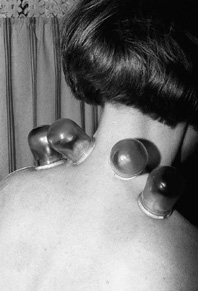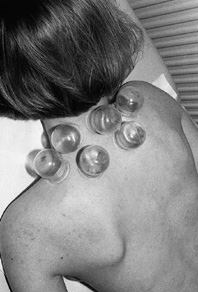Disorders of the Head
Headache
Headache is undoubtedly the most common pain disorder that the therapist encounters in CAM practice. The causes of headache are manifold and occur not only in disturbances in the head region, but also as a result or symptom of an internal disease, injury, high blood pressure, allergy, menstruation, or as an early symptom of serious conditions.
The most common causes of headache include:
• States of internal tension. Depression, fear, accumulated aggression, and exhaustion can all tense the muscles of the neck, which can cause headache. Patients, however, also tend to complain of other symptoms such as sleep disorders.
• Excessive muscle tension in the shoulder and neck muscles, in connection with poor circulation. We see this commonly in patients who strain their shoulder or neck muscles unilaterally or spend time in drafty rooms.
• Disorders of the spinal column.
Because headaches are always a symptom and not a disease, we must first clarify their cause, for example, high blood pressure, liver disease, or allergy.
Symptoms
Headache that is caused by muscle tension or disorders of the spinal column:
• Often persistent headache. Location is mostly in the areas of the neck/back of the head, radiating to the forehead, sensation of cold, misperceptions in the area of the top of the skull.
 Beware! Resistant to pain-killers. Relief of pain by warmth, massage.
Beware! Resistant to pain-killers. Relief of pain by warmth, massage.
Suggested Therapy
In standard cases, a single cupping session (Fig. 7.1) will be sufficient. If necessary, one treatment daily for up to 4 days.

Fig. 7.1 Dry cupping in the neck and shoulder region in segments C4–C6, especially in points that are sensitive to pressure.
 In patients with severe pain, supplemental therapy (neural therapy) is indicated.
In patients with severe pain, supplemental therapy (neural therapy) is indicated.
 In headaches where the source is found in hypertonia or hyperemia, wet cupping is recommended: paravertebral in segments C3–C5.
In headaches where the source is found in hypertonia or hyperemia, wet cupping is recommended: paravertebral in segments C3–C5.
Migraine
Migraine is a particular type of headache. You should, however, only make the diagnosis of migraine when you are dealing with the strictly outlined clinical picture for this disease.
Migraine presents a clearly definable clinical picture whose typical symptoms allow a diagnosis with great certainty. Possible triggers are the psyche, frequently at the onset of menstruation, certain foods, the effects of weather, lack of sleep, and so on.
Symptoms
• There is usually a sudden onset of an attack with half- or double-sided headache, pulsing, severe, aggravated by light and noise, located mostly in the temples or forehead-orbital region, and often accompanied by flickering lights before the eyes, nausea, and vomiting.
Suggested Therapy
In migraine attacks with vasoconstriction of the vessels, cupping (Fig. 7.2) or cupping massage is the “method of choice” (pain relief through warmth).
 In the vasodilatory stage, on the other hand, cupping rarely improves the condition (pain relief through cold). In such cases, cupping is of purely diagnostic significance, and you have to employ other therapies, such as neural therapy.
In the vasodilatory stage, on the other hand, cupping rarely improves the condition (pain relief through cold). In such cases, cupping is of purely diagnostic significance, and you have to employ other therapies, such as neural therapy.
• In migraine, treatment must be initiated early. First to third day, one treatment daily. From the fifth day on, treatments occur every 5 or 7 days.
• Afterwards, intervals between treatments can be increased depending on the results to 14 days at first, and later to 4 weeks. Continue treatment long enough to reach the goal.
 In migraines with vasodilatory manifestations: wet cupping in segments C3–T4.
In migraines with vasodilatory manifestations: wet cupping in segments C3–T4.
Supplemental Therapy
Depending on the case:
• Psychotherapy.
• Phytotherapy. Plant-based psychotropic drugs, for example, St. John’s wart.
• Autogenic training.
• Homeopathy. This disease is very diverse in terms of triggers and manifestations, and also closely related to the disposition and condition of the patient. Hence migraine requires a very precise response and the choice of a far-reaching remedy. In cases where the treatment of migraine is ineffective, you have either chosen the wrong remedy or the wrong diagnosis.
• Neural therapy. In patients with severe pain, quaddle therapy with local anesthetics is indicated as supplemental therapy.

Alternating Therapy
• Neural therapy. Migraine in the vasodilatory stage and in severe headache.
• Acupuncture. Migraine in severe cases, intermittent treatment, acute treatment.
• Electroacupuncture. Can be helpful for vasomotoric pain.
Middle Ear Inflammation (Otitis Media), Tinnitus
Otitis Media
The inner ear and the auditory nerve can be affected by certain disorders that have started anywhere in the body. The middle ear, however, is most susceptible to inflammation, which tends to be caused by an infection ascending from the nasopharyngeal region. Inflammations of the middle ear occur particularly often in infants and toddlers due to special characteristics of their anatomy. The prevention of otitis media depends on how fast you bring infections in the nose and throat into remission.
Symptoms
• Suddenly occurring stabbing pain in the ear.
• Occasional tinnitus, fever.
• Temporarily also loss of hearing.
• Degraded general condition.
• Headache.
Suggested Therapy
Cupping is most effective in accordance with the following formula:
• Acute stage. One treatment per day for 2 days.
• Chronic stage. Here, treatments occur only every 3 or 5 days.
Stay updated, free articles. Join our Telegram channel

Full access? Get Clinical Tree





